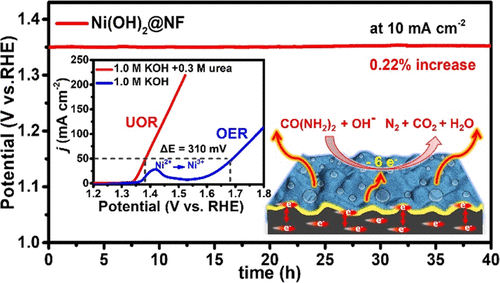当前位置:
X-MOL 学术
›
ACS Appl. Energy Mater.
›
论文详情
Our official English website, www.x-mol.net, welcomes your
feedback! (Note: you will need to create a separate account there.)
In Situ Growth of Porous Ultrathin Ni(OH)2 Nanostructures on Nickel Foam: An Efficient and Durable Catalysts for Urea Electrolysis
ACS Applied Energy Materials ( IF 5.4 ) Pub Date : 2020-02-26 00:00:00 , DOI: 10.1021/acsaem.0c00122
Liaoyuan Xia 1 , Yu Liao 1 , Yan Qing 1 , Han Xu 1, 2 , Zhifei Gao 1 , Wanqian Li 1 , Yiqiang Wu 1
ACS Applied Energy Materials ( IF 5.4 ) Pub Date : 2020-02-26 00:00:00 , DOI: 10.1021/acsaem.0c00122
Liaoyuan Xia 1 , Yu Liao 1 , Yan Qing 1 , Han Xu 1, 2 , Zhifei Gao 1 , Wanqian Li 1 , Yiqiang Wu 1
Affiliation

|
Urea electrolysis is a potential energy-efficient hydrogen (H2) production method that can simultaneously purify urea-rich wastewater. However, the lack of inexpensive and effective electrocatalysts for the urea oxidation reaction (UOR) hampers its widespread use. Herein, hierarchically porous and ultrathin Ni(OH)2 nanostructures in situ grown onto nickel foam (Ni(OH)2@NF) are developed as efficient and durable electrocatalysts for UOR via a simple and cost-effective ultrasonic/heating-assisted activation strategy. The ultrathin Ni(OH)2 nanostructures comprise highly active surfaces and rapid diffusion pathways for active species; meanwhile, the excellent electrical conductivity of the NF skeletons effectively improves the charge transfer of the catalyst. Consequently, this Ni(OH)2@NF electrode exhibits excellent urea catalytic activity (low oxidation potential of ∼1.35 V at 10 mA cm–2) and has remarkable operational stability (potential increase by only 0.22% after 40 h of durability testing) that is superior to most UOR catalysts. By employing the freestanding electrode as the anode and commercial Pt/C supported on NF as the cathode, this two-electrode urea electrolysis cell exhibited a current density of 50 mA cm–2 at a low cell voltage (1.45 V, 250 mV below a urea-free counterpart) with a robust durability (>40 h). This work provides a valuable insight for designing scalable and high-performance UOR electrocatalysts, which are promising for utilization in energy-efficient H2 production.
中文翻译:

镍泡沫上多孔超薄Ni(OH)2纳米结构的原位生长:一种高效且持久的尿素电解催化剂
尿素电解是一种潜在的节能氢(H 2)生产方法,可以同时净化富含尿素的废水。然而,缺乏用于尿素氧化反应(UOR)的廉价和有效的电催化剂阻碍了其广泛使用。在此,通过简单且经济高效的超声/加热辅助活化策略,将原位生长在镍泡沫(Ni(OH)2 @NF)上的分层多孔且超薄的Ni(OH)2纳米结构开发为UOR的高效耐用电催化剂。 。超薄Ni(OH)2纳米结构包括高活性表面和活性物质的快速扩散途径。同时,NF骨架的优异导电性有效地改善了催化剂的电荷转移。因此,这种Ni(OH)2 @NF电极具有出色的尿素催化活性(在10 mA cm –2时氧化电位低至〜1.35 V )并具有出色的操作稳定性(经过40 h的耐久性测试,电位仅增加0.22%)优于大多数UOR催化剂。通过使用独立式电极作为阳极,将商用Pt / C负载在NF上作为阴极,该双电极尿素电解池的电流密度为50 mA cm –2在低电池电压(1.45 V,比不含尿素的同类产品低250 mV)下具有强大的耐用性(> 40小时)。这项工作为设计可扩展的高性能UOR电催化剂提供了宝贵的见识,这些催化剂有望用于高能效H 2生产。
更新日期:2020-02-26
中文翻译:

镍泡沫上多孔超薄Ni(OH)2纳米结构的原位生长:一种高效且持久的尿素电解催化剂
尿素电解是一种潜在的节能氢(H 2)生产方法,可以同时净化富含尿素的废水。然而,缺乏用于尿素氧化反应(UOR)的廉价和有效的电催化剂阻碍了其广泛使用。在此,通过简单且经济高效的超声/加热辅助活化策略,将原位生长在镍泡沫(Ni(OH)2 @NF)上的分层多孔且超薄的Ni(OH)2纳米结构开发为UOR的高效耐用电催化剂。 。超薄Ni(OH)2纳米结构包括高活性表面和活性物质的快速扩散途径。同时,NF骨架的优异导电性有效地改善了催化剂的电荷转移。因此,这种Ni(OH)2 @NF电极具有出色的尿素催化活性(在10 mA cm –2时氧化电位低至〜1.35 V )并具有出色的操作稳定性(经过40 h的耐久性测试,电位仅增加0.22%)优于大多数UOR催化剂。通过使用独立式电极作为阳极,将商用Pt / C负载在NF上作为阴极,该双电极尿素电解池的电流密度为50 mA cm –2在低电池电压(1.45 V,比不含尿素的同类产品低250 mV)下具有强大的耐用性(> 40小时)。这项工作为设计可扩展的高性能UOR电催化剂提供了宝贵的见识,这些催化剂有望用于高能效H 2生产。































 京公网安备 11010802027423号
京公网安备 11010802027423号